Updated December 21, 2009
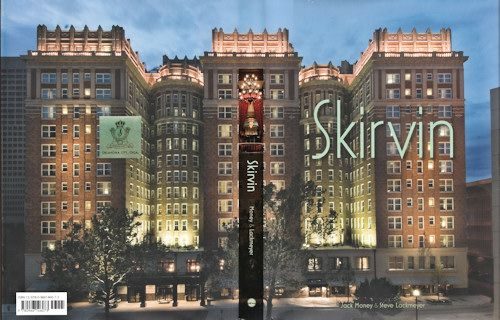
(Click the above image for large view or here for larger still)
Steve Lackmeyer & Jack Money’s new book, Skirvin, had its public debut at a book signing event yesterday evening, December 9, at (where else?) the book’s namesake, the Skirvin Hilton hotel. This article reviews the book, presents a summary, shows you some stuff from it, and shows and tells what others are saying about it.
And, it also warns: While the book is just in time for Christmas, only 1000 copies of the book were included in the first publishing, and only a couple hundred or so remain available as this update is written. Steve told me that whether additional copies will become available in the future is definitely not a sure thing. So, if you sit on your hands and don’t get your copy quickly, don’t say that I didn’t warn you!
First Things Video Interview Other Reviews
My Review & Book Summary
Contents Foreword Chapter 1 Chapter 2
Chapter 3 Chapter 4 Chapter 5 Chapter 6
Chapter 7 Chapter 8 Chapter 9 Chapter 10
Chapter 11 Chapter 12 Epilogue Last Things
FIRST THINGS. Starting with dust jacket cover (above), this book, published by Oklahoma City’s Full Circle Press, is a Class A production from beginning to end. In fact, one of the first things one might want to do after getting one’s grubby hands on a copy is to get a see-through vinyl dust jacket for the dust jacket — this is not your typical dust jacket, it is one that you will want to be sure retains its original appearance over time, trust me. The above photograph of the Skirvin Hilton, taken by Ira Montgomery, which spans the front and back covers and the book’s spine, is simply stunning.
The same goes for all aspects of the production end of things. The book’s design and jacket were done by Carl Brune. Brune also designed the authors’ OKC: 2nd Time Around (Full Circle Press 2006) for which he received a best design award from the Oklahoma Book Awards in 2007. He ought to be a shoe-in for a similar award in 2010 for this work. The paper quality is excellent, the images are sharp and crisp with outstanding color.
VIDEO INTERVIEW. A very well done 11 ½ minute interview by the Oklahoman’s Dave Morris lets you hear what the authors have to say about their book and the Skirvin Hotel. It is presented below. If the video ever goes away from the Oklahoman’s website, I’ve captured the audio as an mp3 file should that become needed.
OTHER REVIEWS. I’ll try to have my review finished here before a day or two passes by. My review with be on the lengthy side, chapter by chapter, and that’s just me. But, for the time being, here’s a nice summary review by Kelley Chambers in the December 2 Oklahoma Gazette. A teaser from the review appears below:
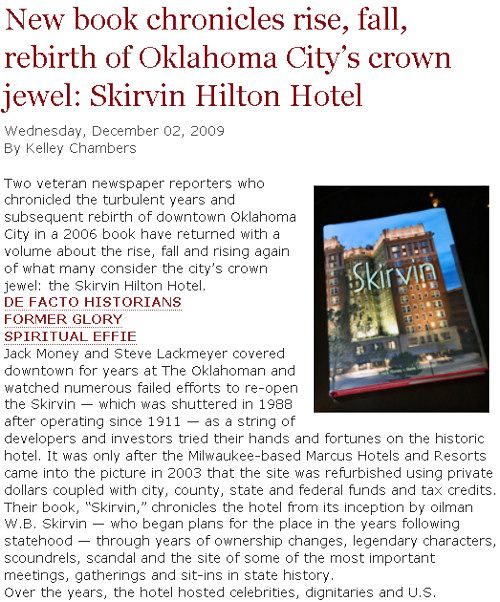
MY REVIEW. I’ll begin by saying that the authors are friends of mine so one might think that my comments are made by one who is wearing rose colored glasses. Were I wearing colored glasses, they wouldn’t be rose colored at all — they would be green with envy. It was my privilege to proofread a draft of this book earlier, and, heck, I found a shitload of mistakes! Just kidding — this book was outstanding even in its draft form.
● Contents. The table of contents, below, shows the breadth of this sweeping story told by the authors. Presented in the book is a story that begins a few years after the 1889 Land Run and runs all the way through today — it is truly a saga which spans more than 100 years, the story of several families, people, events, the city, and even you and me. In a very important way, it is one of the best stories that could possibly be told about Oklahoma City — it includes us all.
Note that chapters are not numbered even though I am doing so for my own convenience.
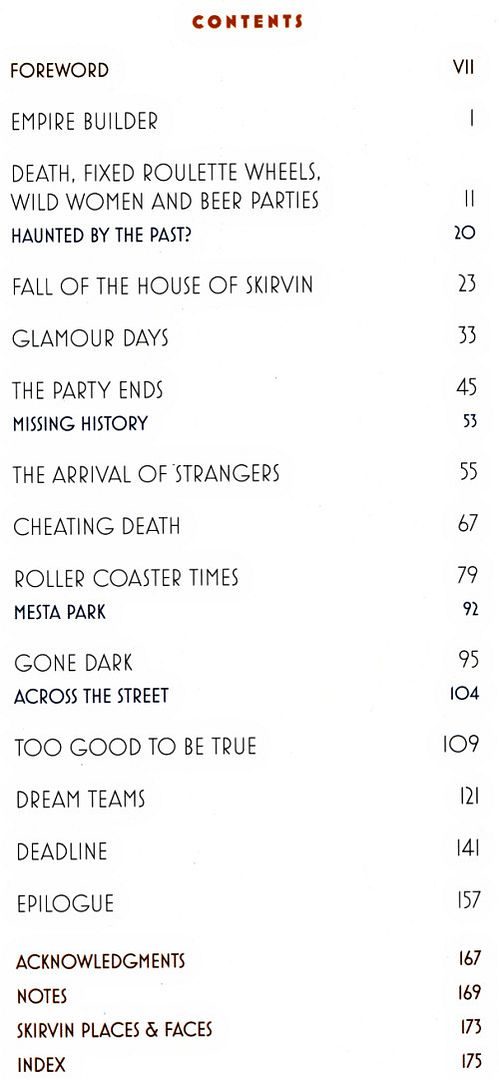
● The Foreword. Ordinarily, nothing particularly special comes in a book’s foreword if such a thing exists in the first place. It is commonly just there, taking up space, and is something to skip over to get to the real stuff. In this book, that’s not so. Read and don’t skip over this foreword. It sets the tone and presents a capsule of all of that which is about to follow from the point of view of one having a long time love affair with the Skirvin. This foreword is written by Robert H. Henry, presently Chief Judge of the US 10th Circuit Court of Appeals and a lifetime appointee on that Court — although it was announced on December 10, 2009, that he will become the new president of Oklahoma City University. But his review and reminiscences span a much larger time than that, as does the book. He once lived in the Skirvin. He concludes this foreword by adding, “Who knows? Someday, I may move back in full time.” The authors could not have chosen more wisely for a way to introduce their text. A snippet from the foreword appears below.
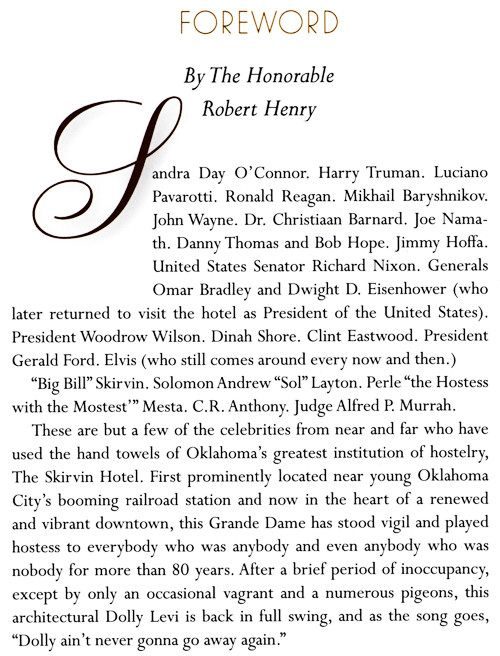
● CHAPTER 1: EMPIRE BUILDER. Here’s a snippet from Chapter 1:
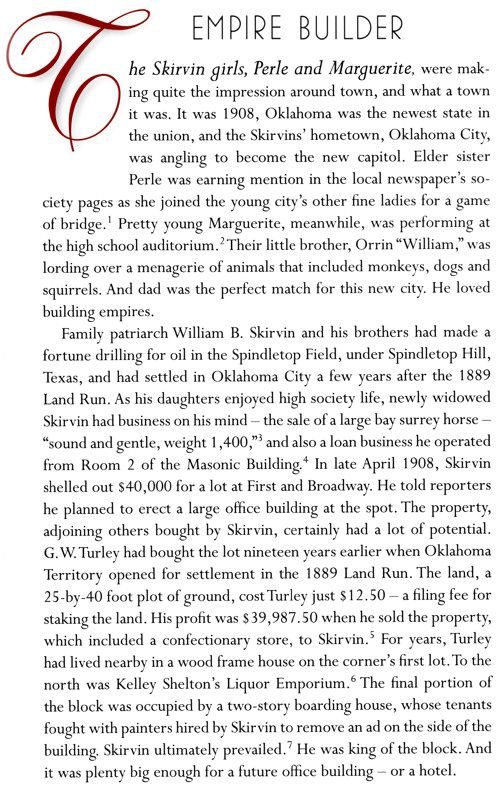
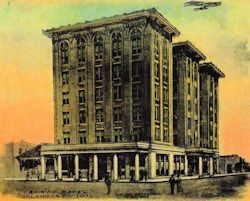
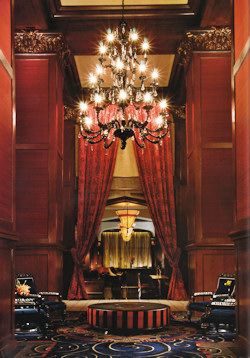 After hitting the oil jackpot in the Spindletop Field near Beaumont, Texas, William B. Skirvin and his brothers settled in Oklahoma City and this chapter describes how Bill Skirvin made his decision to build a hotel and then proceeded to execute it. He purchased the property in April 1908 for $40,000 and told reporters that he planned to build an office building, however he was negotiating with Ned Green to sell the property in the next year. When Ned told Bill of Ned’s mother’s plan to build the biggest hotel in the city, Bill called off the deal. The authors report, “‘That Hetty Green is no dumbbell,’ Skirvin told daughter Perle that night. ‘If she thinks that’s a good site for a hotel, then it probably is.'”
After hitting the oil jackpot in the Spindletop Field near Beaumont, Texas, William B. Skirvin and his brothers settled in Oklahoma City and this chapter describes how Bill Skirvin made his decision to build a hotel and then proceeded to execute it. He purchased the property in April 1908 for $40,000 and told reporters that he planned to build an office building, however he was negotiating with Ned Green to sell the property in the next year. When Ned told Bill of Ned’s mother’s plan to build the biggest hotel in the city, Bill called off the deal. The authors report, “‘That Hetty Green is no dumbbell,’ Skirvin told daughter Perle that night. ‘If she thinks that’s a good site for a hotel, then it probably is.'”
Bill got with the state’s leading architect, Solomon Layton, to do the hotel. Initially, plans were for a 3-wing 6-story hotel, as you can see in the above drawing. But, by the time the hotel opened on September 26, 1911, it became a two-wing ten-story hotel, the largest in the state.
As you can see from the above illustrations in Chapter 1, the authors present a mix of vintage photos and drawings combined with photos of the Skirvin Hilton’s present condition throughout the book. Left of the drawing is a current day photo of the lobby’s junction with the Red Piano Lounge in the background. Throughout this review, click any image for larger views.
An October 1, 1911, Oklahoman ad described the rooms, features, and amenities, and told the public to come on down, and that they did.
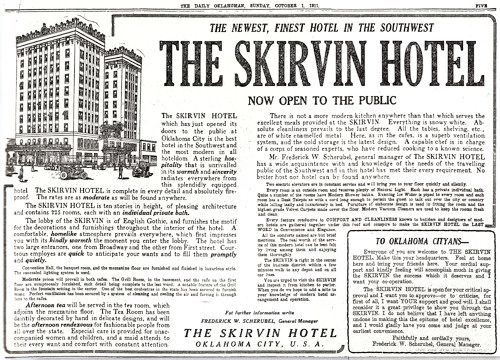
Flashback. The book then takes a turn backward in time and describes how the Skirvins wound up settling in Oklahoma City. This part of the chapter describes the family’s trek from Kansas City to Guthrie shortly after the Land Run, then to a townsite west of Galveston, Alta Loma, which the family developed. As well, the family was involved with the development of Galveston Island and Bill was the president of the Gulf Coast Development Company which lured people from Texas, Kansas, and Missouri to settle there. That would change on September 8, 1900, as shown below. (Note: the authors identify the date as August 5, 1900, but this is a slight mistake. See Galveston County Daily News and this Wikipedia article.)
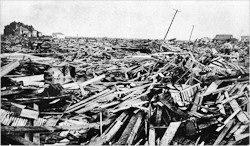 |
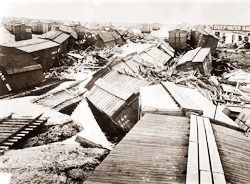 |
The above photos are not in the book but I thought you might want to actually see what happened to Galveston Island and this family’s business interests on that date. One of the largest hurricanes on record pretty much leveled Galveston Island and killed more than 6,000 — some estimates place the number as high as 12,000. Nearby Alta Loma wasn’t spared, either. During this time, Bill’s wife, Hattie, became deadly ill but recovered at least somewhat after treatment in a sanitarium in Battle Creek, Michigan.
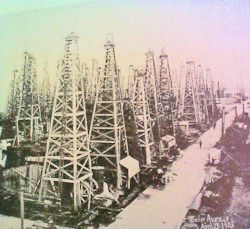 Using remaining funds from their Alta Loma investments, Skirvin bought an acre in the Spindletop Dome area near Beaumont — the discovery of oil there on January 10, 1901, is said to be one of the major oil discoveries ever in this country, and Bill’s acre did the trick for the family’s finances. The image here is not from the book but, I thought you might like to see the Spindletop area in 1903. The authors say that the Skirvins moved to Oklahoma City in 1906, Bill having the intention to begin an oil venture here.
Using remaining funds from their Alta Loma investments, Skirvin bought an acre in the Spindletop Dome area near Beaumont — the discovery of oil there on January 10, 1901, is said to be one of the major oil discoveries ever in this country, and Bill’s acre did the trick for the family’s finances. The image here is not from the book but, I thought you might like to see the Spindletop area in 1903. The authors say that the Skirvins moved to Oklahoma City in 1906, Bill having the intention to begin an oil venture here.
Hattie’s health deteriorated and she died in 1908. Bill never remarried.
Although not described here but instead in a later chapter called “Roller Coaster Times” (my Chapter 8, below) Skirvin built a home at 700 N.W. 16th in 1909 while the hotel was being constructed. (He took title to the lot on which the home was built from Anton Classen’s company (The Classen Company) on January 9, 1909, and Skirvin’s company sold the property to another on August 11, 1911, according to official deed records. This information isn’t in the book but it is described in my own article, The Hostess With The Mostes). After the hotel was completed, the family took up residence there.
Most of the remainder of the chapter describes early day activities in the hotel, where the family stayed, where the kids played, and anecdotal stories about some of the hotel’s visitors. The one that caught my fancy the most was about an Osage Indian, John Stink, one of the hotel’s first guests. Then having stayed three days, the housekeeper reported to Skirvin that his bed had yet to be slept in. Skirvin had gone to great trouble to obtain the finest of beds, and he was concerned when asking Mr. Stink, “‘What’s the matter, John?’ Skirvin asked. ‘My housekeeper says your bed hasn’t been slept in for three nights. Anything wrong?’ ‘Nothing wrong,’ the Osage replied. ‘Bed too soft. Slept on floor.'”
● CHAPTER 2: DEATH, FIXED ROULETTE WHEELS, WILD WOMEN AND BEER PARTIES. Here’s a snippet from Chapter 2:
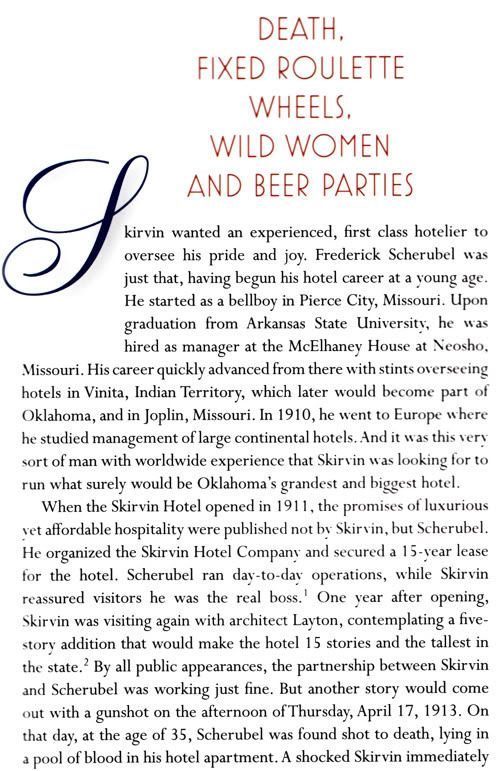
The first chapter describes a bit of the early history of Bill Skirvin’s family and how Bill wound up getting into the hotel business. This chapter gives a similar treatment to the early days of the Skirvin Hotel and describes a couple of “Twilight Zone” elements of the place itself.
After a few preliminaries, the chapter discusses the 1st of those eerie elements, the last two years of the life of the initial manager of the hotel, Frederick Scherubel. He had contracted with Skirvin to operate the hotel and formed the Skirvin Hotel Company for that purpose — he had a 15-year lease on the hotel. His operation of the hotel began in April 1911, but it came to an end on April 17, 1913, only two years later when, on that date, he was found in his hotel apartment shot to death and his body was found in a pool of blood.
The fundamental historical questions, “who, what, when, where, how, and why,” are alluded to by the authors but they are a cautious pair and they never specifically ask, nor answer, those questions, except for “where and when” which are historical facts. Instead, the authors present various facts and circumstances and leave it for the reader to conjure possible answers to “who, what, how, and why.” Was it a suicide (as local authorities determined) or was it murder (the authors take care to avoid use of the m-word)? Read this section and make your best guess — it’s the 1st Twilight Zone topic for your consideration in this chapter.
The story then branches to the hotel’s 10th floor which contained large rooms which were ideal for salesmen’s use as temporary showrooms — legitimate functions of a hotel which catered to commercial as well as ordinary customer demands and needs. But, did the 10th floor embrace other demands, vice related, as well? Apparently, it did. Shortly after Scherubel’s death, a rigged roulette wheel was found there, and other possible instances of vice, although hearsay and/or circumstantial, are described as well.
Leaving the dark side, the authors then turn to a brief description of Bill Skirvin’s daughters, Perle, the eldest, and Marguerite, her junior. The latter was an aspiring actress and the book contains the program of one of her early-day-silent-film movies staring Tyrone Power — the December 1914 program is located in the album of teenager Theresa Reinhart, part 4 of my Reinhart Legacy series. (Incidentally, the “Tyrone Power” was the father of the Tyrone Power Jr. who many of us recall from his outstanding 1930s-1950s movies.) In the meantime, Perle was sent by her father to attend a music school “back east” and he lavishly supported her during that time. While there, the authors describe that she met George Mesta, a millionaire businessman from Pittsburgh and that they married — the authors didn’t say this but the marriage was in 1917. The authors don’t say this either, but the marriage was apparently over Bill Skirvin’s strong objection. See my Perle Mesta article or click here for more about that. The book contains more about Perle in “Roller Coaster Times” (which I have dubbed Chapter 8).
Coming forward a few years, the chapter gets into the 1920-1930 period and several rare and stunning photos from the Daily Oklahoman’s archives punctuate the hotel’s development during this time. A third wing, 13-stories, was added on the east side in 1925-26 and the two 10-story west wings would be raised to that height in 1929-1930, giving the overall final form of the Skirvin that we know today (other than the swimming pool and, later, ballroom extensions on the north side). Compare the images from Larry Johnson’s Historic Photos of Oklahoma City (Turner Publishing Co. 2007) and Skirvin (this book), below (click images for larger views):
| 1925-1926 Skirvin Only East Wing Is 13 Stories From Johnson’s Historic Photos  |
1929-1930 Expansion West Wings Expanded to 13 Stories From Skirvin 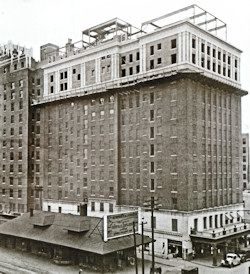 |
In the book’s photo at the right, notice that the Rock Island passenger depot is still present.
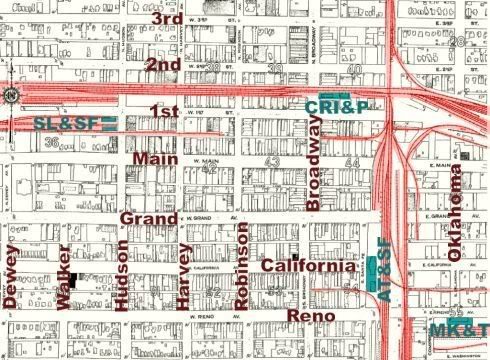 Los Angeles, El Paso, Amarillo, Little Rock, Hot Springs, Memphis 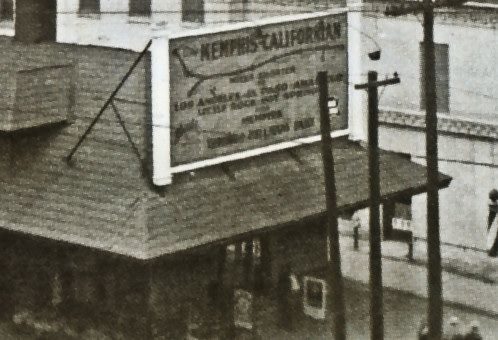 |
The above expansion of the Skirvin brought it to the configuration we know today (except for the later swimming pool and/or ballroom additions on the the north side) and in this period the coffee shop (today, the Park Avenue Grill) and the Venetian Room were added.
Properly speaking, the chapter comes to an end around 1929-30 when Bill Skirvin began contemplating yet another hotel across the street, the Skirvin Tower, intended to be a 28-story skyscraper. However, a two-page interlude is inserted at the end, sort of a sub-chapter, called “Haunted by the Past,” and this is the second “Twilight Zone” element of the chapter. It discusses the oft-told folk-tale(s) of hotel maid Effie and her possible ghost that may be walking the Skirvin’s halls and guest rooms even to this day. Did Bill Skirvin become intimately involved with her during the days of Prohibition, and did Effie bear his child, and did she leap with the child from a hotel window to their deaths, and does Effie’s ghost still haunt the elegant Skirvin Hilton? Who knows — get a room, turn up your sensory perceptions to maximum overdrive, and find out for yourself!
● CHAPTER 3: FALL OF THE HOUSE OF SKIRVIN. Here’s a snippet from Chapter 3:
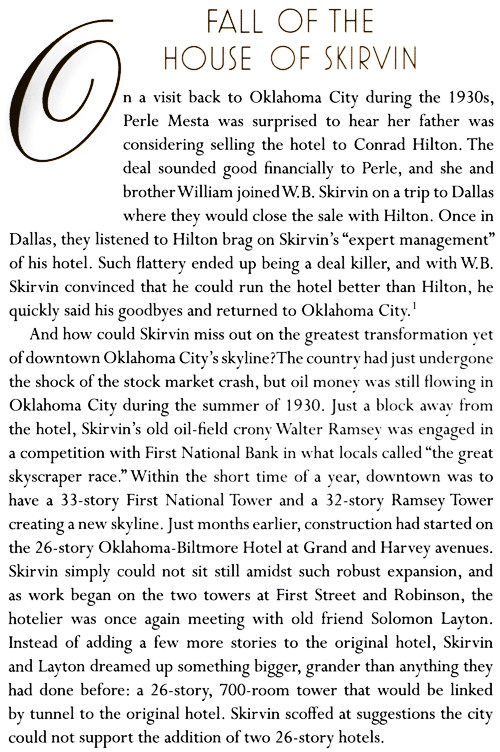
The chapter begins with a description of how Bill Skirvin, with the support of children Perle and her brother William, very nearly sold the hotel to Conrad Hilton but that Bill, receiving praise from Mr. Hilton as to his hotel management skills, decided not to sell but to continue his own ownership. Vanity must also have played a role in Skirvin’s decision to keep up with the Jones, so to speak, in the building boom that was going on downtown with the construction of the Ramsey Tower, First National, and Biltmore Hotel during 1930-1931, for that is the time that Bill got together with Solomon Layton again and laid plans for another hotel, the Skirvin Tower, which would be a 28-story 700-room hotel. Before planning was done, the project was designed so that it could be expanded by another 8 floors to reach a 36-story height which would make it taller than either First National or the Ramsey Towers’ 33-story height. We know today that those big plans never happened, but Bill was dreaming big.
One of the features of the new project would be a pair of underground tunnels under Broadway which connected the two Skirvin properties. That, however, was a novelty which city ordinances might not allow (the tunnels would have to be constructed under a city street, after all) and Bill was getting into legal fusses with the city over that and other matters and with a brother’s family members concerning oil company stock ownership. Those fusses, though eventually resolved satisfactorily, would be the least of Bill Skirvin’s legal difficulties between 1931 and 1945, as will shortly be observed.
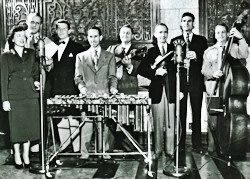 The original plan for the Skirvin Tower was that it would open in 1931 but that got changed to 1932. The Great Depression finally hit home in Oklahoma City and the initial building’s size was cut back to 14 stories, plus two basement levels. Before that happened, though, construction stopped above ground at 6 stories in but resumed in 1935. By that year, the Skirvin Tower had at least a pair of marquee tenants, upscale women’s clothier Balliet’s and WKY Radio which moved from its Plaza Court location in 1935 to occupy the 5th floor. Complete with its own pipe organ and orchestra room, it was called by NBC Vice President Frank Mason as “the most modern studio in the world.”
The original plan for the Skirvin Tower was that it would open in 1931 but that got changed to 1932. The Great Depression finally hit home in Oklahoma City and the initial building’s size was cut back to 14 stories, plus two basement levels. Before that happened, though, construction stopped above ground at 6 stories in but resumed in 1935. By that year, the Skirvin Tower had at least a pair of marquee tenants, upscale women’s clothier Balliet’s and WKY Radio which moved from its Plaza Court location in 1935 to occupy the 5th floor. Complete with its own pipe organ and orchestra room, it was called by NBC Vice President Frank Mason as “the most modern studio in the world.”
In the earlier litigation, Bill’s children were supportive. But, around 1937-38 or so, son William discovered that father Bill had apparently been transferring American Oil company stock from the children to himself so that he could raise capital to finance the Skirvin Tower development. That discovery led to multiple federal court lawsuits between the father and children which would span six years, from 1938 through 1944. The litigation even resulted in the appointment of a receiver during parts of that time which not only chilled development of the Skirvin Tower but also proper development of the Skirvin Hotel itself. The chapter describes that litigation more fully, but it is sufficient in this summary to say that the 10th US Circuit Court of appeals ruled in Bill’s favor in 1944.
By that time, Bill Skirvin was 84 years of age. In 1945, shortly after his court victory and while a passenger in an automobile driven by a friend on NW 63rd Street, the friend’s vehicle was apparently forced off the road by another automobile and Bill sustained injuries in the resulting crash which proved to be fatal. In the hospital about 10 or so days before his death, his children visited and made peace with him. Three days before his death, Bill interrupted Perle when she was making her apology and said, “Why, I’ve forgiven you. There’s nothing but love in my heart for all three of you children. You’re all I have.”
● CHAPTER 4: GLAMOUR DAYS. Here’s a snippet from Chapter 4:
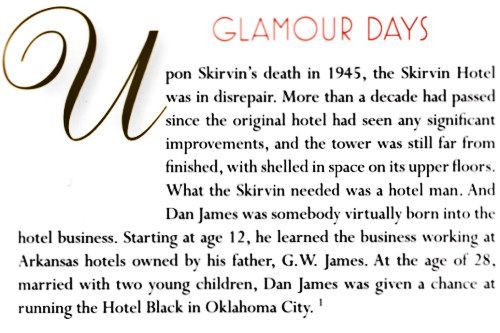
During the father vs. children litigation, the hotel had fallen into some degree of disrepair and the Skirvin Tower was still undone. In May 1945, the children sold the properties to Dan James who had operated the smaller Black Hotel for a number of years. The authors describe 1945 through 1960 or so as the Skirvin’s “Glamour Days.”
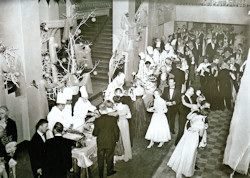 Some of Dan James’ first steps were to get the Skirvin back into shape. He modernized the hotel and its furnishings and, in 1955, added air conditioning to the Skirvin. He also attended to the Skirvin Tower by changing the name of the Silver Glade room to the Persian Room which became a hot spot for the city’s elite. It is shown in the photo to the right.
Some of Dan James’ first steps were to get the Skirvin back into shape. He modernized the hotel and its furnishings and, in 1955, added air conditioning to the Skirvin. He also attended to the Skirvin Tower by changing the name of the Silver Glade room to the Persian Room which became a hot spot for the city’s elite. It is shown in the photo to the right.
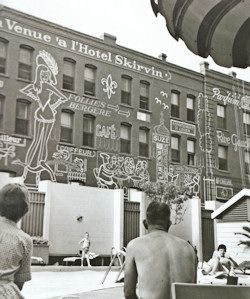 During this time (although the Skirvin was never in short supply of celebrity visitors), politicians Harry Truman, Dwight Eisenhower, Richard Nixon, slept on beds in the Skirvin. The book contains a 1946 letter from Eisenhower to Dan James which reads, “Dear Mr. James: Thank you for your timely generosity in offering me scotch from your private supply. Sincerely, Dwight Eisenhower.” Recall, of course, that Oklahoma was then a dry state. Even so, the same type of courtesy had been extended to Harry Truman during his election campaign against Thomas Dewey. The chapter highlights several of these celebrity visitors, including actor Glenn Ford and comedians Dean Martin and Jerry Lewis — and some particularly gnarly anecdotes are described in the chapter about them, especially Jerry.
During this time (although the Skirvin was never in short supply of celebrity visitors), politicians Harry Truman, Dwight Eisenhower, Richard Nixon, slept on beds in the Skirvin. The book contains a 1946 letter from Eisenhower to Dan James which reads, “Dear Mr. James: Thank you for your timely generosity in offering me scotch from your private supply. Sincerely, Dwight Eisenhower.” Recall, of course, that Oklahoma was then a dry state. Even so, the same type of courtesy had been extended to Harry Truman during his election campaign against Thomas Dewey. The chapter highlights several of these celebrity visitors, including actor Glenn Ford and comedians Dean Martin and Jerry Lewis — and some particularly gnarly anecdotes are described in the chapter about them, especially Jerry.
As seen above, an outdoor pool north of the main building was added in the mid-1950s and after Prohibition was repealed in 1959 a club was added one floor up from the pool, the Sun Suite, where those inclined could sip on a martini and watch those a level below enjoy the pool — it was the only outdoor pool in the downtown area.
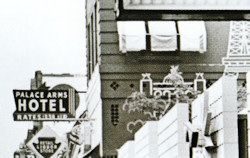 Another tidbit: The pool-art was added in 1961. Two Oklahoman articles reported that some of the text, intending to represent French spelling, got the spelling wrong and the other article actually made fun of it. |
● CHAPTER 5: THE PARTY ENDS. Here’s a snippet from Chapter 5:
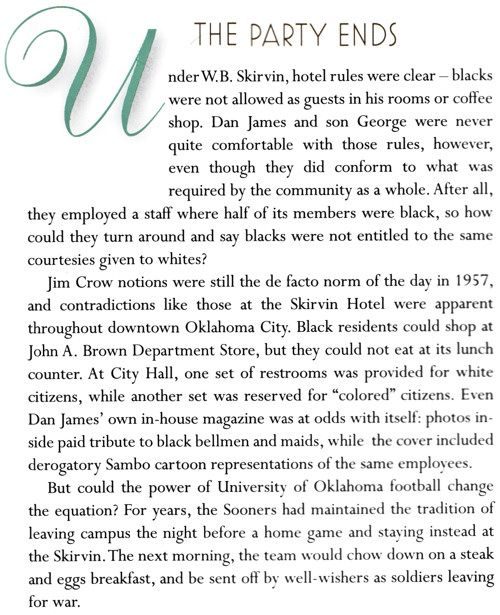
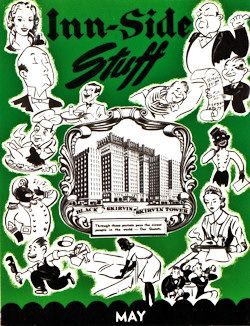 Race. As to racial issues, the Skirvin was no different than almost if not all white-owned public accommodation businesses from the city’s beginnings through the mid-1960s — blacks were not allowed. Recall that James owned three hotels — the Black, the Skirvin Tower, and the Skirvin. The image at right is the cover of a company magazine in an unspecified year but presumably in the late 1950s. The caption below the image in the book reads, “A company magazine published by hotelier Dan James provides a confused glimpse at life working at his hotels. The magazine cover depicts a cartoonish Sambo representation of black employees. But the magazine’s coverage is respectful and complimentary to those same workers.”
Race. As to racial issues, the Skirvin was no different than almost if not all white-owned public accommodation businesses from the city’s beginnings through the mid-1960s — blacks were not allowed. Recall that James owned three hotels — the Black, the Skirvin Tower, and the Skirvin. The image at right is the cover of a company magazine in an unspecified year but presumably in the late 1950s. The caption below the image in the book reads, “A company magazine published by hotelier Dan James provides a confused glimpse at life working at his hotels. The magazine cover depicts a cartoonish Sambo representation of black employees. But the magazine’s coverage is respectful and complimentary to those same workers.”
The chapter describes that blacks were a substantial and respected component of Skirvin employees and that, relatively speaking in this time, blacks held positions of greater prominence than they did in other city hotels, even if blacks could not get a room at the hotel and even if black employees would sit at separate tables during annual employee Christmas banquets.
What To Do About Prentiss Gautt. Prentice Gautt attended Douglass High School in Oklahoma City and became the 1st black football player at the University of Oklahoma, attending from 1956 to 1959. An outstanding running back, he was a two-time All-Big Eight player and the 1959 Orange Bowl MVP and in his senior year he was named to the academic All-American team. He was posthumously inducted into the College Football Hall of Fame in May 2005. These days, a hotelier would see it as an honor for such a person to stay in one’s hotel — but that was then and now is now. In Dan James’ day, Gautt’s presence in the hotel presented a serious problem.
Legendary Coach Bud Wilkinson wanted to win football games and, to that end, he was a pioneer in this state’s racial progress when he added Gautt to his roster as its 1st black player in 1956. For a number of years before its home games, the OU football team would spend Friday night at the Skirvin before a home game, eat a hearty meal on Saturday morning, and then travel down to Norman and whack up on its foes. On October 4, 1957, the team arrived at the Skirvin to partake of that established ritual — but this time, Prentiss Gautt was a member of the team.
Would Gautt be allowed to spend the night, and would the black bar come to an end at the hotel if he did? The press, perhaps particularly the black press, was following the event, and the answers were, yes, he was, but no, it didn’t. The authors describe how that one night stand ended the tradition of the team spending the night in the Skirvin before game day then proceeds to cover the Skirvin’s involvement with Oklahoma City’s late-50s to early-60s civil rights sit-ins which, at long last, resulted in the hotel’s racial integration in 1963. The Skirvin became the city’s 1st hotel to accept all racial comers.
Unions. While Clara Luper’s NAACP approach embraced non-violence, efforts to unionize hotel employees during this time was not as restrained. While those attempts always failed, there was always a battle and, sometimes, the battles were coupled with notes like the one which appeared at the desk of Dan James’ son, George, reading, “We know where you live. Is your family safe? We know where your kids go to school.”
Liquor. Even though Prohibition was the law of the state from 1907 until 1959, hoteliers were tacitly allowed to serve “liquor by the wink” by lax law enforcement. The election of governor J. Howard Edmondson in 1958 brought the promise of Prohibition’s repeal or its strict enforcement. The enforcement part which came first caused events to be canceled, business to suffer, and employees to be laid off. Although Prohibition was repealed in 1959, damage had been done.
By the time the early 1960s arrived, Dan James and son George had lived through the above but at a price. An alternate title to the chapter could easily have been, “Burnout.”
● CHAPTER 6: THE ARRIVAL OF STRANGERS. Here’s a snippet from Chapter 6:
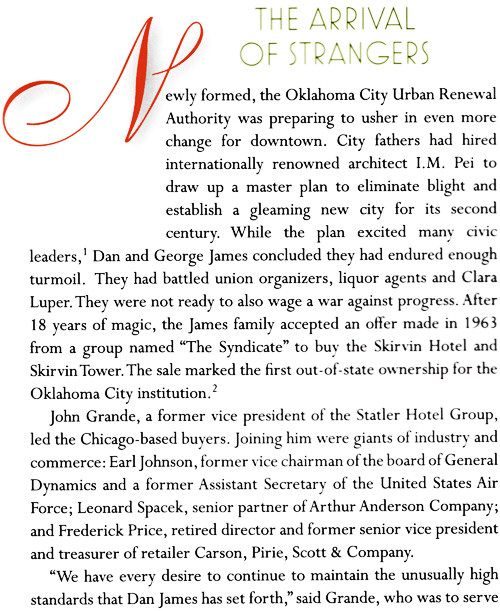
… more coming soon
● CHAPTER 7: CHEATING DEATH. Here’s a snippet from Chapter 7:
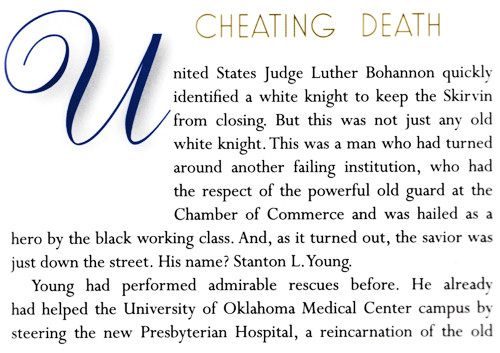
… more coming soon
● CHAPTER 8: ROLLER COASTER TIMES. Here’s a snippet from Chapter 8:
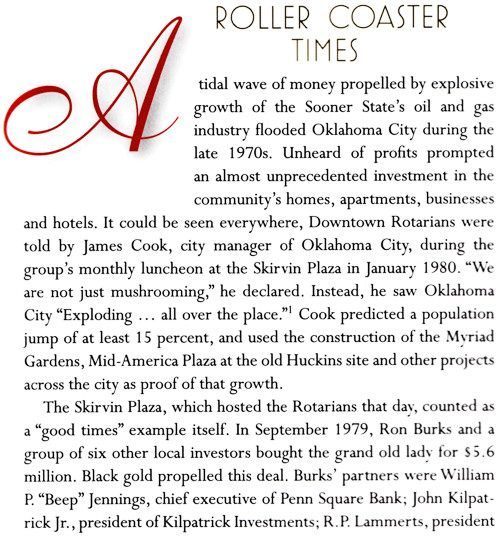
… more coming soon
● CHAPTER 9: GONE DARK. Here’s a snippet from Chapter 9:
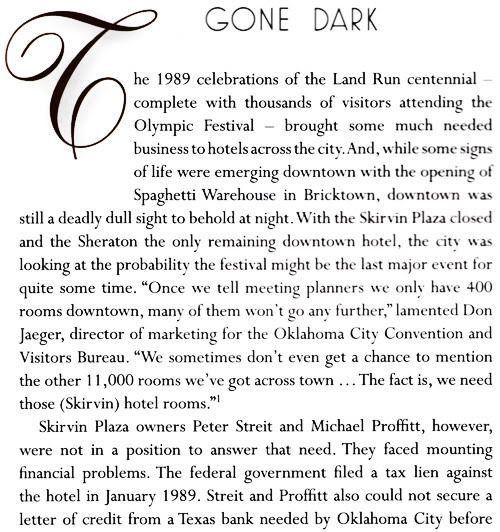
… more coming soon
● CHAPTER 10: TOO GOOD TO BE TRUE. Here’s a snippet from Chapter 10:
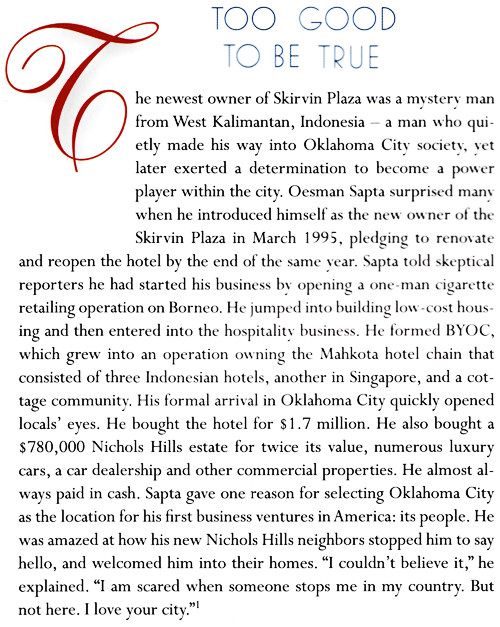
… more coming soon
● CHAPTER 11: DREAM TEAMS. Here’s a snippet from Chapter 11:
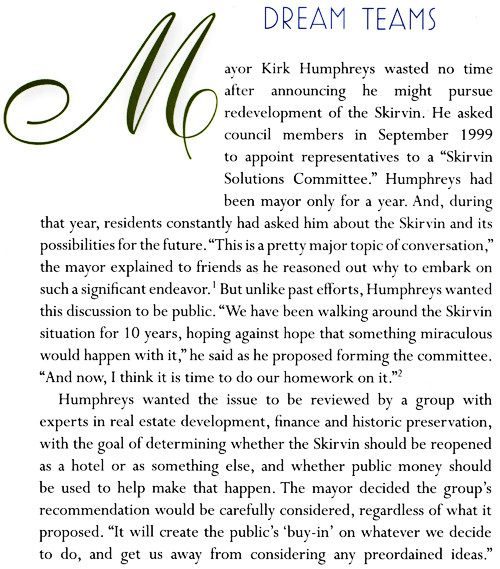
… more coming soon
● CHAPTER 12: DEADLINE. Here’s a snippet from Chapter 12:
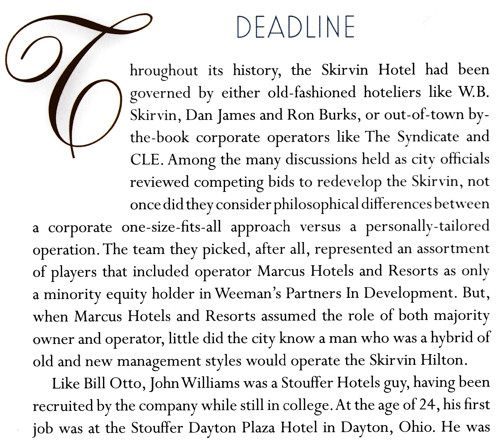
… more coming soon
● EPILOGUE. Here’s a snippet from the Epilogue:
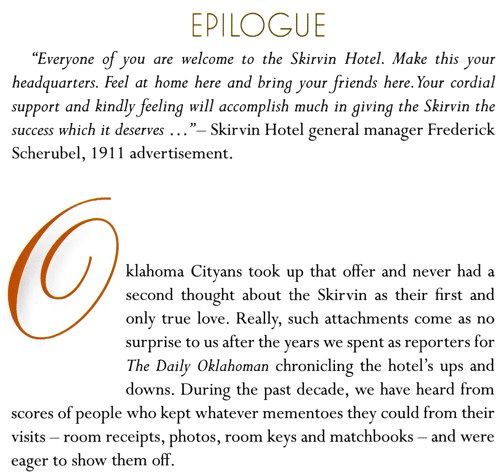
… more coming soon
● LAST THINGS. These include the acknowledgments, endnotes, places and faces, and the book’s index, and they will not be further detailed here.
But, I will add these closing remarks and opinions.
If you are familiar with this, my OKC History blog, you may have noticed that, for me, like many of us, the Skirvin is near and dear to my heart — see Skirvin Preview, Skirvin Hilton – the Day Before, The Grand Reopening, and The Skirvin Hilton, should you have missed those articles. Call me a Skirvin junkie and I’d be proud to have the title. By the same token, I am also one who would have high demands and expectations about a book written about the Skirvin.
So, when I much earlier learned that these authors were set upon a course to write this book, I had these preliminary sensations and thoughts: (1) I had already read, reviewed, and been bowled over by, their magnificent OKC: 2nd Time Around. I do not know of any book that chronicles a period of time in this city’s history better that that book does. None. Being thusly impressed I could think of none who could possibly do better justice to this place that I love (and I own and have read a heck of a lot of OKC history books). One of the preeminent marks of these authors is that they not only tell the facts, they tell the story behind those facts. It is not only in the fact-telling that makes for good history, it is in the story-telling that the facts become alive. Would the authors give me this same experience? (2) Would the production be excellent, just as it was done in OKC: 2nd Time Around? I’m aware that the authors flirted with at least one other publisher which would have likely answered that question in the negative and in which production quality, if not content, could have been seriously diminished. (3) Would I learn something from this book that I didn’t already know, being the Skirvin junkie that I am?
My answer to all three questions is an unqualified, “Yes, Yes, and Yes!” (1) The facts in detail are told, but, as and if not more importantly, the “story” which surrounds those facts which make the facts come to life is presented robustly, as well, and without a publisher’s censor review. Who would know better how to do that than on-the-beat newspaper reporters like these guys? They are steeped in gathering facts and then telling the stories. (2) The quality of production is simply outstanding, probably even better than the authors’ OKC: 2nd Time Around which was superb in its own right. The images shown in this book are impeccably sharp and crisp and the paper quality is excellent. This is due to the quality of production of books published by Full Circle Publishing. I’m aware that the authors had previously made arrangements for a different publisher to do their book but that they backed away from that deal because of production and possibly content concerns, and at some cost to themselves. If you applaud the authors’ choice in that regard and like what you see, they deserve your applause for insisting upon a better book-publisher arrangement. Otherwise, the book that is yours to have would be much different than it is. (3) A huge amount of “new” to me information was learned from this book than I had previously known, Skirvin junkie that I am.
In short, I didn’t fork out $39.95 each for two books (one for me, one as a birthday present for my son) for no reason at all. I did it because I wanted one, and I did it because I wanted my son to know more about the wealth and depth of his city’s history, and the Skirvin saga is truly a story which enamors, inspires, and embraces us all. We, too, are part of the Skirvin saga.
I suppose that you can tell that I liked the book. My advice: buy it while you can — it may not long be available.
